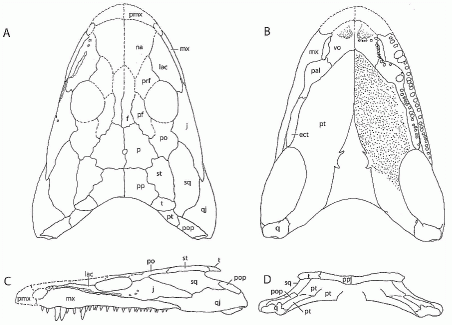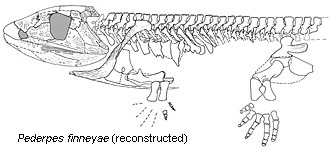
Pederpes finneyae, life reconstruction, by Dmitry Bogdanov.
Wikipedia, GNU Free Documentation/Creative Commons Attribution
| Tetrapoda | ||
| The Vertebrates | Whatcheeriidae |
| Vertebrates Home | Vertebrate | Vertebrate |
|
Abbreviated Dendrogram
Sarcopterygii
│
└─Tetrapoda
├─Acanthostega
└─┬─Ichthyostega
└─┬─Hynerpeton
└─┬─Tulerpeton
└─┬─Ossinodus
└─┬─○Whatcheeriidae
│ ├─Pederpes
│ └─Whatcheeria
└─┬─Crassigyrinus
└─┬─Colosteidae
│ └─Greererpeton
└─┬─Spathicephalus
└─┬─Baphetidae
├─Eucritta
└─Tetrapoda*
├─Temnospondyli
└─┬─Lepospondyli
└─Reptiliomorpha
|
Contents
Overview |
 Pederpes finneyae, life reconstruction, by Dmitry Bogdanov. Wikipedia, GNU Free Documentation/Creative Commons Attribution |
About twenty million years separate the Late Devonian with its assemblage of fish-like early tetrapod fossils and the amphibian fossils known from the late part of the early Carboniferous (the Viséan). The late Devonian forms were barely more than lobe-fin fish with legs, the middle Carboniferous was populated by a diverse assemblage of small and large amphibains, everything from crocodile to salamnder to snake and eel like forms. there were even animals that may have been the first reptiles. During this mysterious interval, from which for a long time little or no fossil remains were known, the evolution of land animals underwent a sort of Cambrian explosion of its own. The interval has been referred to as Romer's gap, after the great vertebrate paleontologist Alfred Sherwood Romer, who first recognised it.
Recently, the analysis of a primitive amphibian (early tetrapod) gave us a glimpse into this lost world.
Pederpes finneyae was originally discovered in 1971 in central Scotland and classified as a lobe-finned fish. Its fossils were found in the Ballagan Formation. The type specimen was a nearly complete, articulated skeleton. Only the tail and some bones of the skull and limbs were missing. It was not until 2002 that Jennifer Clack named and reclassified the fossil as a primitive tetrapod. (Wikipedia). it is the only nearly complete tetrapod known from the Tournaisian age . The only other Tournaisian tetrapods known are disarticulated and fragmentary material from the Horton Bluff Formation of Nova Scotia. These represent several taxa, not much can be known of them, although they can be very speculatively placed in other groups such as Ichthyostegids and Colosteids on the basis of general appearance of isolated leg bones.
Pederpes was a stocky animal about a meter in length, the same size as Ichthyostega and other early tetrapods. In contrast to the many toed (polydactyl ) paddle-like feet of the late devonian tetrapods, it had (on the fore foot or hand at least) five toed foward-facing feet like that of later land animals. Although it is not known if the hind feet had five toes, the foot has characteristics that resemble the feet of later, more terrestrial Carboniferous forms.
The high, narrow skull was another innovation. it is possible that Pederpes breathed by inhaling with a muscular action like advanced tetrapods, rather than by pumping air into the lungs with a throat pouch the way many modern amphibians do. The shape of the skull and the fact that the feet face forward rather than outward indicate that Pederpes was well adapted to land life. It is currently the earliest known fully terrestrial animal, although the structure of the ear shows that its hearing was still much more functional underwater than on land, and may have spent much of its time in the water and could have hunted there. (Wikipedia)
Pederpes closely respembles a slightly later (post-Romer's Gap) American form called Whatcheeria (during this time Europe and Northe America were part of a single land mass), and has been placed with it in the family Whatcheeriidae. Occidens portlocki, a partial mandible known from the Visean of Northern Ireland may also be whatcheeriid and there are even two tentative whatcheeriid identifications are from below the gap, in the late Devonian of Pennsylvania and Russia (Clack and Finney, 2005, via Warren 2007).
Recently the Australian taxon Ossinodus pueri was assigned to this group, as analysis by Warren and Turner (2004) placed it as the sister taxon to Whatcheeria and Pederpes. A more recent study has given more ambiguous results ( Warren 2007), and it is possible that Ossinodus represents a more primitive evolutionary grade. Indeed, the whole idea of a monophyletic group of early tetrapods may simply be an artefact resulting from a lack of sufficient material, shared primitive features, and not taking into account convergence, homoplasy, and collective character reversal (for example, groups like the Coelophysoidea and Pistosauridae were previously considered clades but are now known to be paraphyletic grades). Until more material turns up it will be impossible to say for sure. For now we can refer to Whatcheeriids and Whatcheeriid-like forms such as Ossinodus, and the quite distinct but equally archaic and primitive Crassigyrinus as an assemblage of transitional forms intermediate bridging the temporal, morphological and phylogenetic gap between the aquatic late Devonian ichthyostegalian grade of tetrapods and the more famnilar and diverse Paleozoic leposondyl, proto-temnospondyl and reptiliomorph amphibians and proto-amniotes of the middle to late Visean onwards. MAK111112

Ossinodus: O. pueri
mid Viséan of Queensland (Ducabrook Formation)
Tetrapoda : Acanthostega + (Ichthyostega + (Hynerpeton + (Tulerpeton + (Whatcheeriidae + (Crassigyrinus ::: Tetrapoda*)) + * )))).
Comments: Although originally included under the Whatcheeriidae, new reconstruction of the skull and body shows an animal quite different in form. Phylogenetic analyses give different results depending on whether or not Ossinodus is reconstructed with or without an intertemporal bone. If the former, Ossinodus remains in the Whatcheeriidae, if the latter, it is more basal, indicating that the Whatcheeriidae may be a grade rather than a clade. Warren 2007)
Image: Skull reconstruction, from Warren 2007. Note how flat the skull is, a primitive feature. Obviously, that the actual specimen is not nearly this complete
Links: Wikipedia (very stubby page when last checked) MAK111112
Whatcheeriidae: Pederpes, Whatcheeria
Early Carboniferous (Tournaisian to Viséan)
Tetrapoda ::: Ossinodus + ((Crassigyrinus ::: Tetrapoda*) + * : Pederpes + Whatcheeria)
narrow, steep-sided skull with orbit deeper than its width; massive tooth on maxilla about position 5 or 6; light dermal skull ornament (Clack 2002b)
Comments: As Ossinodus is more primitive than the other two genera placed here, the family Whatcheeriidae is quite possibly a paraphyletic grade as originally defined (Warren 2007). For this reason Ossinodus is given a separate entry, and cladistic as opposed to linnaean) Whatcheeriidae is defined as including Whatcheeria and Pederpes, and any other related forms. These animals were about a metre in length, with a large, triangular head.
Links: Wikipedia (very stubby page when last checked) MAK111112

Pederpes: P. finneyae
Range: Late Tournaisian (Ivorian) of Scotland (Ballagan Formation, Inverclyde Group)
Whatcheeriidae : Whatcheeria + * .
primitive stapes most closely resembling that of Acanthostega in a narrow skull with a deep wide temporal notch (Clack 2002b)
Comments: The only diagnosible specimen from Romer's gap Pederpes is known from a nearly complete articulated skeleton. It is the earliest known animal with five functional toes, and the earliest vertebrate to show the beginnings of fully terrestrial movement. Distinguished from the closely related Whatcheeria by a spike-like latissimus dorsi (an arm muscle) attachment on the humerus and several minor skull features. Despite the probable presence of a sixth digit on the forelimbs it was at least functionally pentadactyl. (Wikipedia)
References: Clack 2002b
Links: Wikipedia, Palaeocritti - Pederpes finneyae, Reptile Evolution - Ihthyostega MAK111112
Whatcheeria: W. deltae Lombard and Bolt, 1995
Viséan of Iowa
Whatcheeriidae : Pederpes + * .
Skull deep and snout pointed. Shares with earlier stem tetrapods a series of lateral lines across the skull, rows of teeth on the palate, and small Meckelian foramina across the surface of the lower jaw. It has a cleithrum, a bone in the pectoral girdle that extends from the scapula. The cleithrum once attached to the skull in lobe-finned fish, the ancestors of tetrapods, but detached to allow the neck to move freely. . the opening at the top of the skull behind the eyes (the parietal foramen) is relatively large. The bones on the skull surface are unusually smooth, unlike the pitted skulls of many other early tetrapods. In front of the eye socket, the prefrontal bone forms a prominent ridge. The prefrontal also projects downward to cover a possible sinus. (Lombard & Bolt1 995, via Wikipedia)
Comments: Closely related to Pederpes, although living some fifteen million years or so earlier. Like that genus, possesses a mixture of both primitive and derived traits. MAK111112
Page by MAK111112